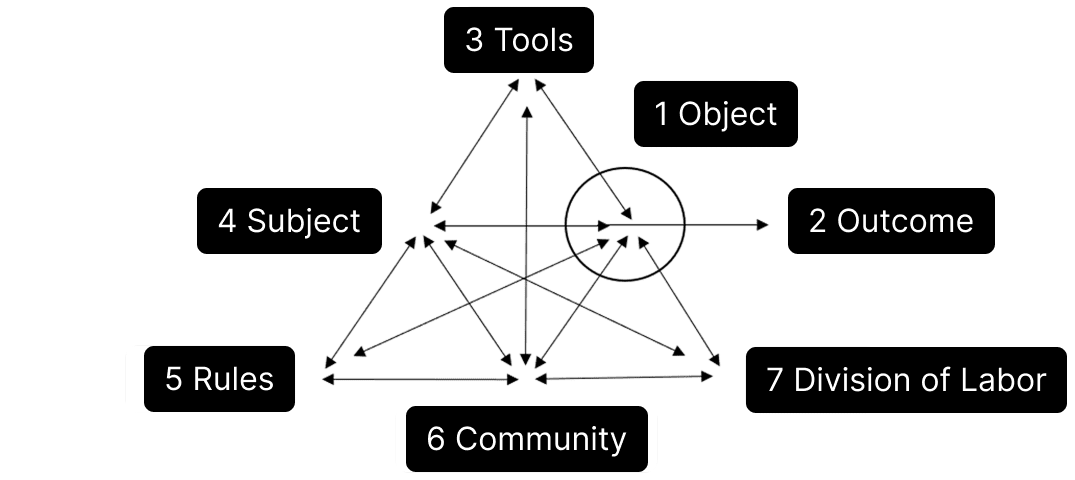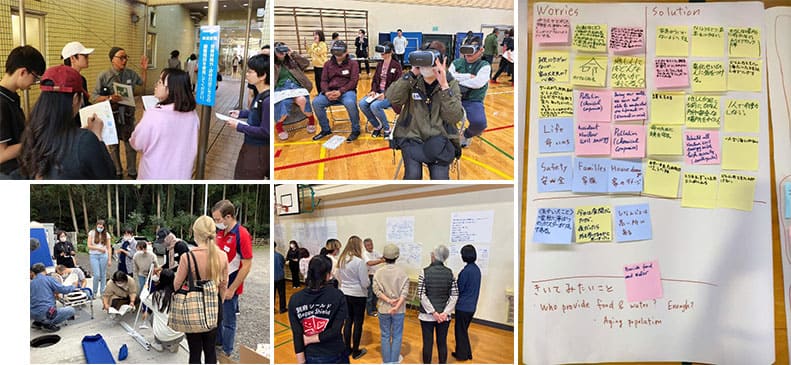Aiming to Connect People through Language Education
Categories:
Overview
Implementing language education centered on connections with society by complementing vertical learning with horizontal learning
To date, the main purpose of Japanese language education at universities particularly at the beginner level, has been the acquisition of knowledge through the teacher-student relationship of “teaching and being taught,” with textbooks serving as the primary medium. However, APU currently incorporates practical education in its courses, allowing students to gain new insights and perspectives, transform their thinking, and accordingly take the lead in their own learning. Expanding learning beyond the confines of the classroom and introducing out-of-classroom learning into the classroom gives rise to uncertainty and diversity. Students bring such insights into conscious awareness and engage in critical reflection with classmates, which can be expected to promote further learning. Through such activities, I strive to implement education that expands learning. (Related research [1])
In this research project, I aim to draw out students’ agency and autonomy by combining vertical learning that focuses on knowledge accumulation, with horizontal learning facilitated through exchange with others, thereby realizing language education that leads to practical and continuous learning.
Disaster Preparedness Town Tour —organized around the theme of disaster preparedness—is an example of a practical activity aimed at expanding learning. In this activity, international students enrolled at APU join local residents on group walks through Beppu City in Oita Prefecture, where the university is located, deepening exchange as they visit evacuation centers and disaster preparedness facilities. Japan is a new environment for these students, and many of them from countries where earthquakes and other natural disasters are rare. Disaster preparedness community walks therefore provide an opportunity for such students to gain valuable knowledge about disaster preparedness, however the significance of these activities extends far beyond mere knowledge acquisition. While experiencing practical communication and building relationships with local residents, the students expand their own learning. Classroom-based learning and practical experiences in real-world settings fuse organically in a process that cultivates a deeper understanding of language, improved learning motivation, and a drive to engage with society.
This initiative grew out of my experiences during the Kumamoto earthquakes in 2016, which affected the neighboring Oita Prefecture, and led to the establishment of numerous evacuation shelters in Beppu City, where APU is located. An investigation in the wake of the earthquakes showed that some international students had little to no awareness of earthquakes and panicked as the language barrier prevented them from obtaining critical information. At the same time, it became apparent that some local residents who encountered international students for the first time were uncertain about how to engage with them at evacuation facilities. As those issues came to light, I felt it was not only important to focus on language but also to get to know one another while gaining a better understanding of the city, leading to the discovery of the new theme of “connecting people through language education.” I recognized that students need to learn autonomously while engaging with society and the community, and therefore began to organize practical activities and conduct related research.

Novelty/Originality
Aiming to build an environment in which students can utilize their agency to expand their learning through a practical approach
In this research project, I propose an approach that expands the traditional framework of language education. The central idea is to realize expansive learning that encourages students to engage in self-directed learning through a fusion of vertical and horizontal learning. Traditional language education has emphasized the accumulation of language knowledge, such as grammar and vocabulary (vertical learning). This form of learning pursues “correctness.” In this research project, we aim not only to complement the traditional approach but also to intentionally create opportunities for students to encounter diverse values and ways of thinking (horizontal learning), thereby building an environment where they can proactively broaden their own learning.
The backdrop for this initiative is the multilingual and multicultural environment provided by APU, where roughly 3,000 international students from over 100 countries have gathered, a rare environment even by global standards. The bulk of these students reside in Beppu City, and their Japanese proficiency levels vary widely. Many of these students hardly understand any Japanese when they enroll at the university. It is therefore essential to expand their learning not only through passive-style vertical learning, but also by incorporating everyday-life situations in Beppu City.
This concept took shape in the form of a learning design centered on connections with real-world contexts. Disaster preparedness community walks and other activities that involve exchange with the local residents are opportunities for international students to engage in communication at a practical level. They also foster autonomous learning as they encourage students to actively take part, instead of being passive participants under the supervision of an instructor. By organically linking classroom-based learning with practical application in the local community and thus ensuring students remain aware of the purpose and function of what they learn, I believe these activities can become a catalyst for deeper learning as university students.
The research on the changes that can be brought about by these activities among students and local residents has only just begun. Going forward, as international students become actively involved in the social issue of disaster prevention, they are likely to discover their own role and transmit their experience to new international students, thereby creating a continuous learning cycle. Furthermore, while international students and local residents engage in activities together, we can expect mutual understanding to be fostered spontaneously, leading to the formation of new communities through language learning. I believe this initiative shows one of the potential approaches toward a new language education model for a society that embraces multicultural coexistence.

Engeström’s general model of an activity system (based on Engeström, 2015/2020, p.118; Yamazumi, 2019, p.19).
In thinking about activities to broaden the traditional framework of language education, I have referred to Engeström’s general model based on activity theory to devise and implement a framework for activity.
Related research
Related research [1]
Classroom Activities to Foster Learner Agency in Japanese Language Learning: Toward a New Pedagogical Approach to Expansive Learning ― Japanese Language Education, No. 186, pages 32–46 (Co-authored)
Connecting People through Disaster Preparedness Community Walks ― Activity Record ― The booklet for the activities of engaging “Disaster Prevention Town Disaster Preparedness Town Tour”
Awareness Survey on Disaster Preparedness among International Students who Participated in Disaster Preparedness Activities ― Based on Analysis of the Interview Survey
Principal Investigator

Ritsumeikan Asia Pacific University
You can view and print a summary of this page's contents in a single PDF page here.







Natural disasters can affect anyone, but related risks can also be increased or mitigated through individual actions. I believe that individuals coming together to think about their roles in a disaster scenario, where mutual support between people is essential, ultimately contributes to the creation of a safe and welcoming society. Rather than considering responses to such problems individually, I believe it is important to create spaces for dialogue in which each person can understand how to take action within a larger framework.
Which teaching and research initiatives should be undertaken to build connections among individuals? I am still exploring the answer to that question, but I believe language classes can offer opportunities in this respect, precisely because they are held on a daily basis. I therefore aim to further expand the possibilities of language education in collaboration with students.
Ritsumeikan Asia Pacific University Faculty Information
researchmap